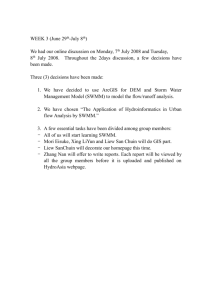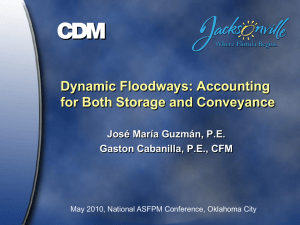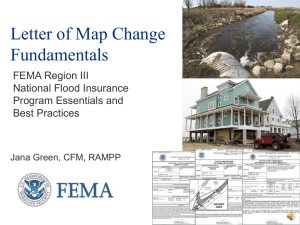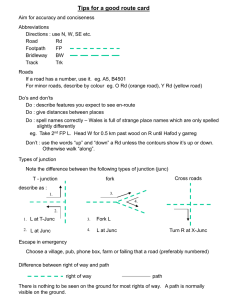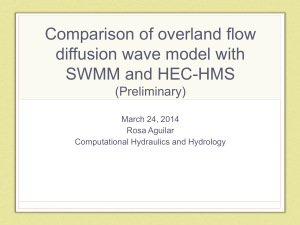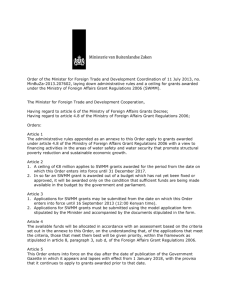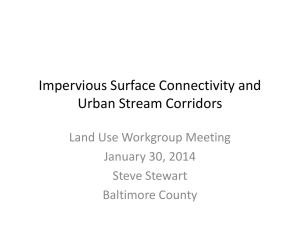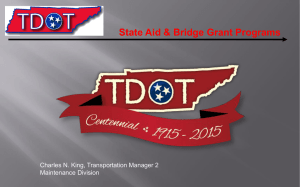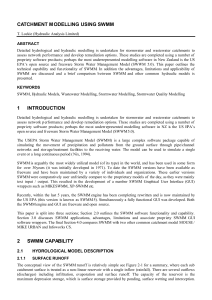Using the Power of SWMM Unsteady Modeling for CLOMR
advertisement
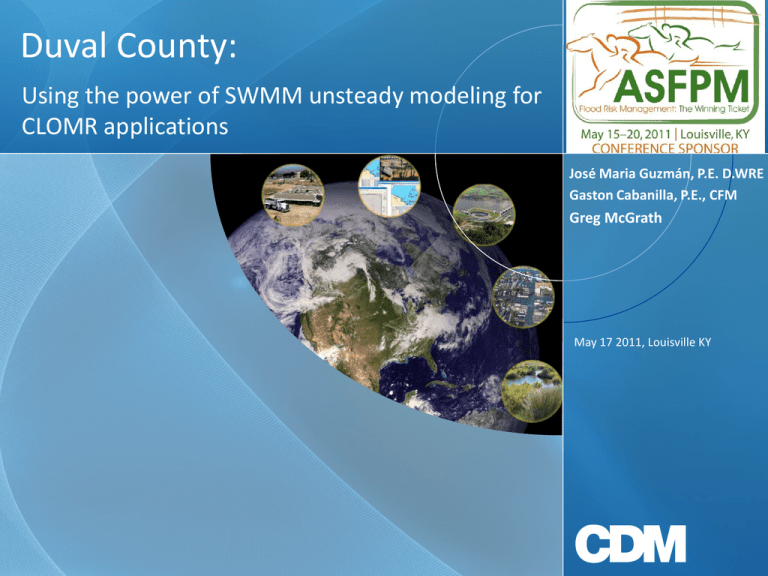
Duval County: Using the power of SWMM unsteady modeling for CLOMR applications José Maria Guzmán, P.E. D.WRE Gaston Cabanilla, P.E., CFM Greg McGrath May 17 2011, Louisville KY Agenda • • • • Project Technical Background Flood Insurance Study Documents based on SWMM LOMC Process using SWMM Conclusions/Discussion Acknowledgments: Tom Nye, Michael F. Schmidt, Sandeep Gulati, Seungho Song, Erin Hardin, Katie Lytle. Project Technical Background • Community opted to use SWMM for several reasons – Previous models with successful model calibrations – Complex system with multiple culverts, ditches and closed conduits – Hydraulics are driven by tail water conditions – Timing between different tributaries is relevant – Agreement with local regulations driven by 24 hour duration storms – Concurrent TMDL studies – Public domain software • By having one single model, the City can keep updated one tool that is benefiting from continuous work in the LOMC, TMDL, and ongoing activities Some experienced CFMs might need to get familiar with results from SWMM • Model data are structured differently in SWMM than in other more traditional software: Variable HEC RAS SWMM Discharge Cross Section Link WSE, Stage Cross Section Node Velocity Cross Section Link Floodway Width Cross Section Link Floodway Surcharge Cross Section Node • Hydrology and Hydraulics are solved simultaneously in SWMM • No need to solve tributaries separately, and account for backwater curve with a dynamic stable simulation Little Cedar Creek • Hydrology – Tributary Area: 6 Square Miles – 14 Subcatchments • Hydraulics – 74 Nodes – 83 Links 2010 DFIRM Panel Generated with SWMM Output Stream Profile using RASPLOT and showing SWMM Nodes FIS Discharge Table Floodway Data Table in staggered format Example of Map Revision Application using SWMM Proposed 4-Lane Causeway and Bridge Proposed Urban Development Without Floodplain Encroachment LOMC Process, What to submit • Completed application forms. • Narrative on project and submittal (optional but very helpful). • Hydrologic Computations (if applicable) along with digital files of computer models used. • Hydraulic Computations (if applicable) along with digital files of computer models used. • Certified topographic map with floodplain and floodway (if applicable) delineations. • Annotated FIRM and/or FBFM to reflect changes due to project • Items required to satisfy any NFIP regulatory requirements. • Fee payment if applicable. The LOMC process requires the use of several forms • SUMMARY OF FORMS • There are six forms plus a payment form that needs to be prepared, • Form 1 - Overview & Concurrence (All revisions) – Requester , community official, and engineer signatures • Form 2 - Riverine Hydrology & Hydraulics – Scope and methodology of hydrologic and/or hydraulic analyses • Form 3 - Riverine Structures – Hydraulic structures in the stream channel or floodplain. • Form 4 - Coastal Analysis – Scope and methodology of coastal analyses LOMC Process • Form 5 - Coastal Structures – hydraulic structures constructed along the coast • Form 6 - Alluvial Fan Flooding – information for analyses of alluvial fans • Payment Information – Information regarding any fees paid for a CLOMR, LOMR, or External Data Request. CLOMR Process for this case • Form 1 - Overview & Concurrence (All revisions) – Identify that it is CLOMR or LOMR – Community Number, Name, State, Map Number, Panel Number, and Effective Date – Flooding source name , type of flooding (Riverine) For this example FORM 2 and 3 are required • Form 2 - Riverine Hydrology & Hydraulics – Duplicate Effective Model • Is a copy of the hydraulic analysis used in the effective FIS – Corrected Effective Model • is the model that corrects any errors that occur in the Duplicate Effective Model – Existing or Pre-Project Conditions Model • Modifications to produce the Existing or Pre-Project Conditions Model to reflect any modifications that have occurred within the floodplain since the date of the Effective model but prior to the construction of the project – Revised or Post-Project Conditions Model • Modified to reflect revised or post -project conditions For this example FORM 2 and 3 are required • Form 3 - Riverine Structures – request involves a new bridge – Indicate the reason for the new bridge – Indicate the model used to analyze the hydraulics at the bridge (SWMM) – Attach plans of the structure certified by a registered professional engineer • Payment Information – Fees paid for a CLOMR Effective Model is available in SWMM5 • 100 yr Storm: 12.3 inches in 24 hours • The model took less than a minute to run 30 hours for the entire stream • Peak Flow at proposed project site: + 1,600 cfs , - 150 cfs Effective Model Peak WSE Results • Each node reports the peak HGL (WSE) • Note that many conduits peak around hour 21 (9 hours after the storm peak) Existing Pre-conditions Effective Model • In anticipation of the proposed conditions, the user adds cross sections at critical locations • This represents pre-conditions model • There could be a BFE change due to new cross sections Proposed Model – Bridge Addition in SWMM • State/Local criteria: no WSE increase is allowed • Federal criteria: no increase allowed in floodway areas • Peak Upstream WSE : 5.8 ft at Hour 16 • No encroachment • Two rows of bridge piers • Lower Chord Elevation: 6.8 ft • Adding the bridge takes up to 60 Minutes SWMM Reports model information differently than HECRAS and this has implications in the location of cross sections • In anticipation of the proposed bridge, HECRAS users would add four cross sections • In order to extract the same information from SWMM the user should add nodes and links as shown LC_Junc LC20008L2S LC20008L3 Le_Junc Node Link Cross Section User estimates the length of contraction and expansion reaches • Based on proposed bridge geometry the user can determine the following using HEC methodology • Lc = 20 ft • Le = 40 ft • Rounded to nearest 10 ft LC_Junc LC20008L2S LC20008L3 Le_Junc Node Link Cross Section Proposed Model needs to show no WSE increase • Net 3 cfs decrease in discharge upstream of bridge. User compares Peak WSE Results with effective model and compares floodway results • Floodway Peak Stages: • • • • Cannot increase 100 year storm stages per Florida regulations. Cannot increase Floodway with or surcharge per FEMA regulations. Florida regulations control for this case. End result is a proposed bridge with no floodplain encroachment. An Updated Floodway Table is generated using the SWMM results • Floodway widths are also verified NODES LINKS BASE FLOOD WATER SURFACE ELEVATION FLOODWAY FLOODING LOCATION DISTANCE FLOODWAY BASE PEAK WIDTH (FT) FLOW (CFS) (FT) WITHOUT BASE PEAK VELOCITY REGULATORY FLOODWAY (FT NAVD) (FT NAVD) (FPS) WITH FLOODWAY (FT NAVD) SURCHARGE (FT) LITTLE CEDAR CREEK C20007L1 268 2026 2.9 85 2117 0.7 292 1646 1.9 306 7868 1.4 472 31271 1.4 4796 20007L1 C20007 5709 20007 C20008L3 6406 Le_Junc Le_Chan 6446 20008L3 Lc_Chan 6466 Lc_Junc C20008L2 200 1765 2.6 343 1615 1.0 7143 20008L2 C20008L1 5.1 5.1 5.4 0.3 5.2 5.2 5.6 0.4 5.4 5.4 5.8 0.4 5.3 5.3 5.7 0.4 5.4 5.4 5.8 0.4 5.8 5.8 6.6 0.8 Conclusions • SWMM users can find the required information for FEMA LOMC applications • When the model for the entire watershed is used, there is no need to pre-establish the domain of influence of new developments • The dynamic simulation requires attention to model results to verify timing, direction and magnitude of flows. • Duval County has developed a tool that can assist in FEMA mapping, urban planning, permitting, and water quality evaluations
